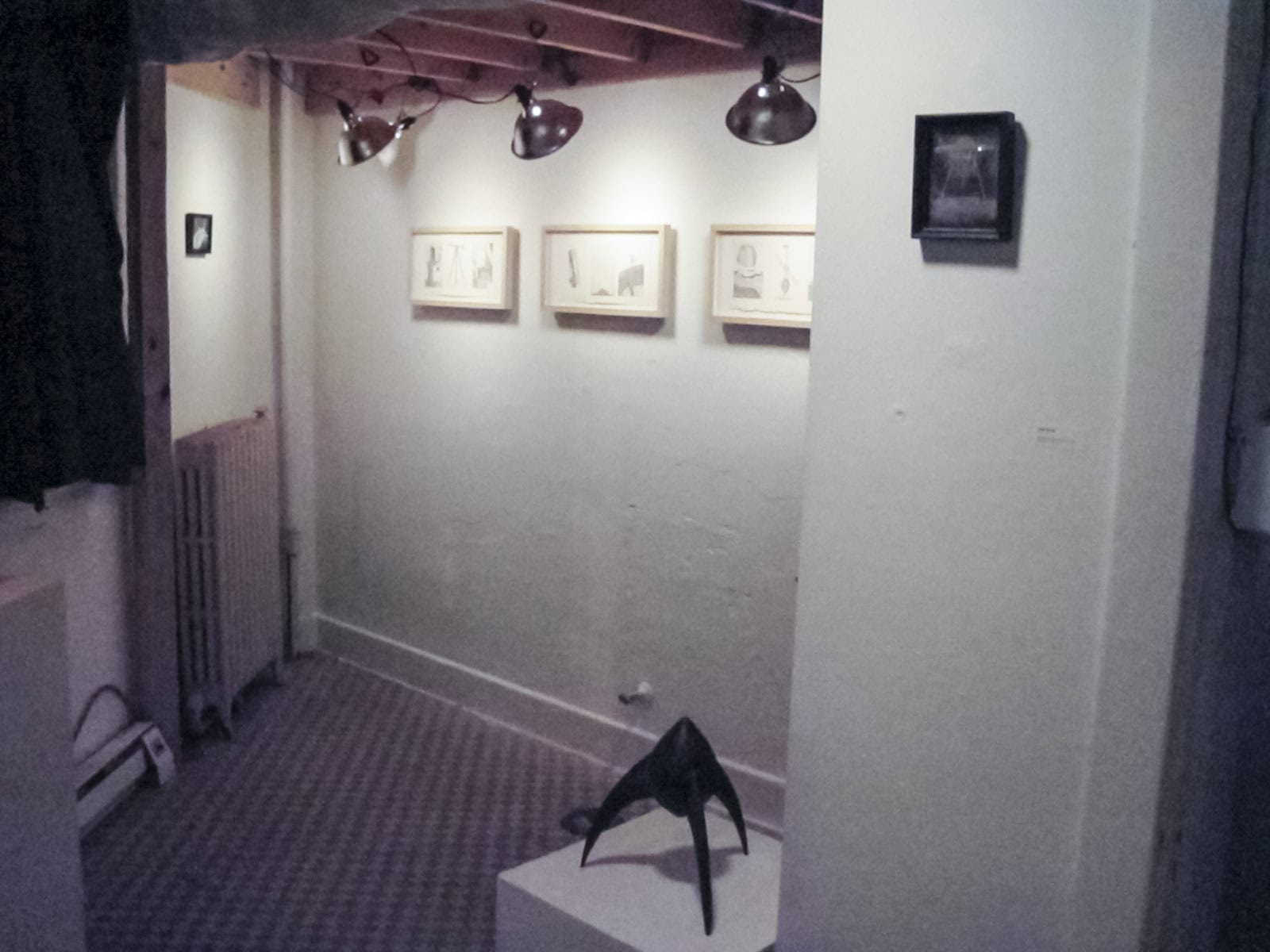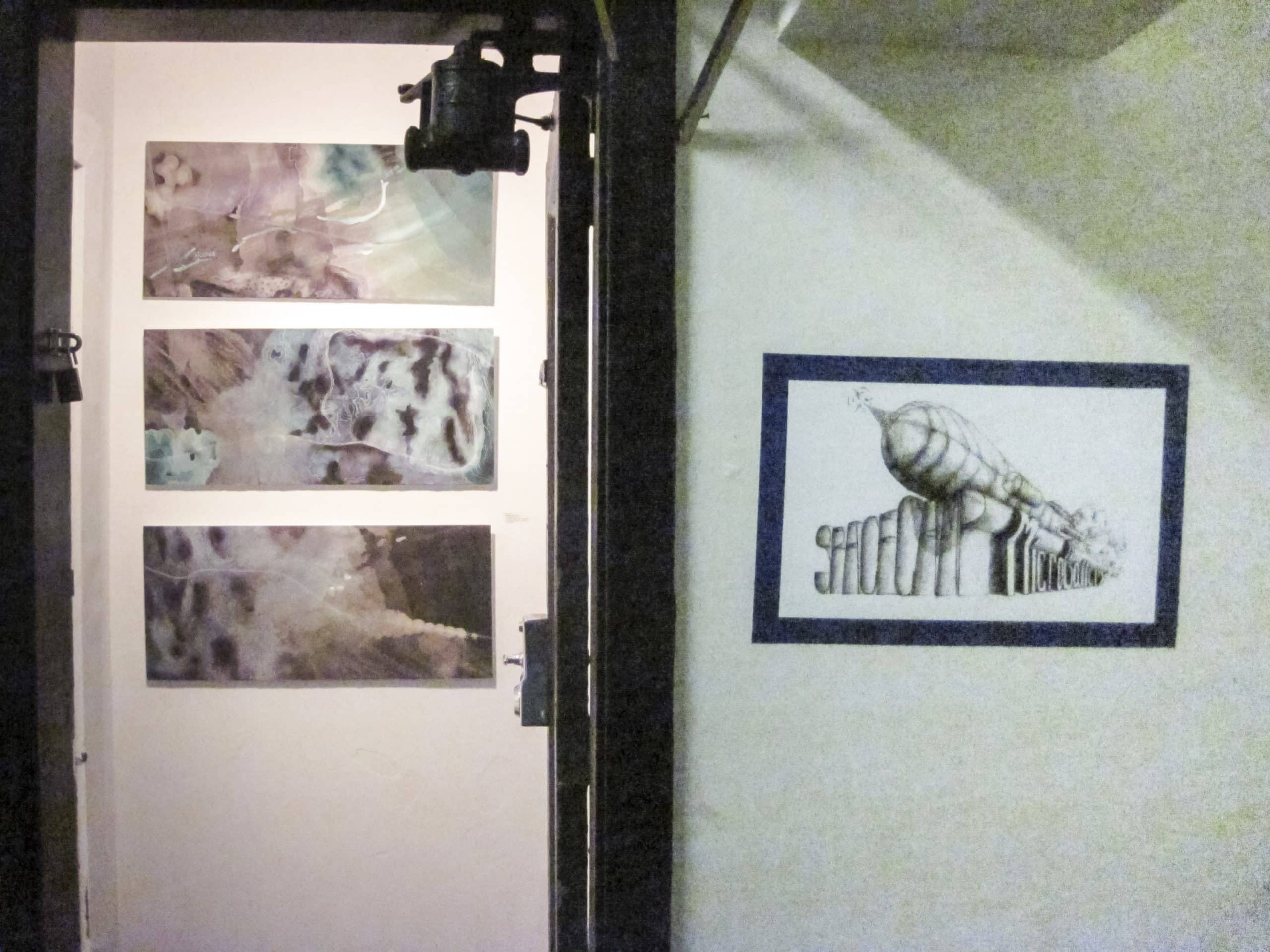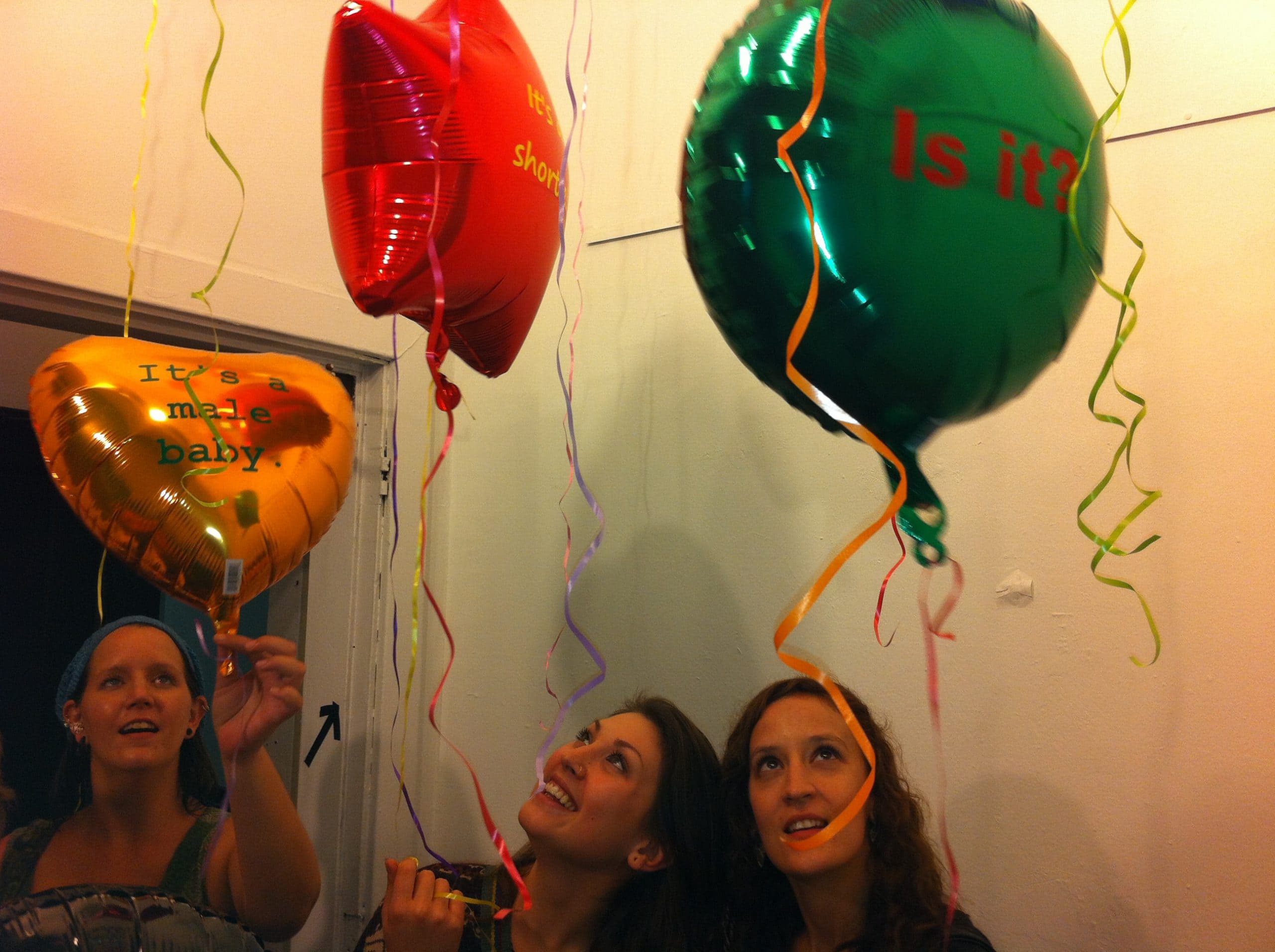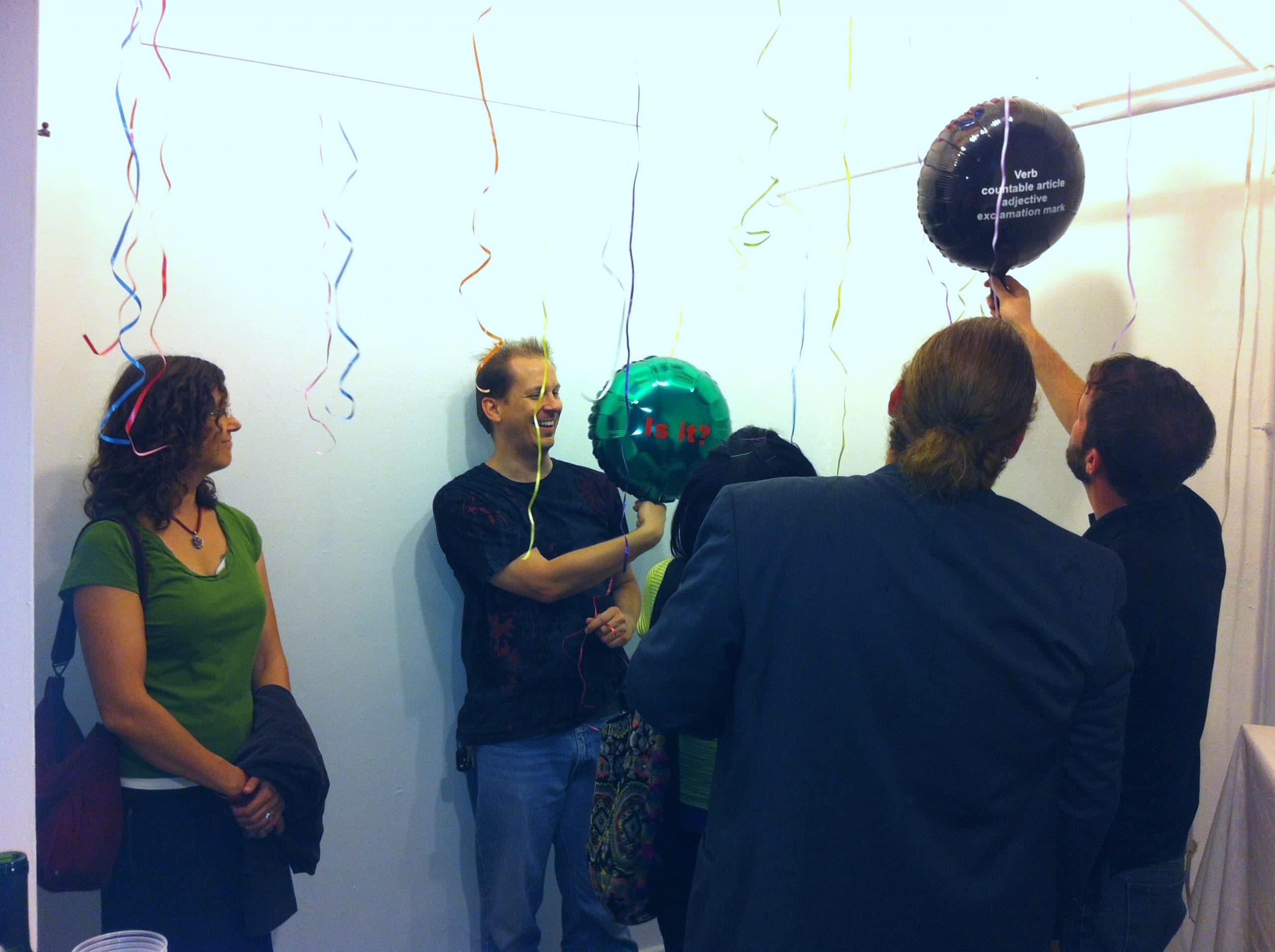![]() Gallery Statement by Founder
Gallery Statement by Founder
SpaceCamp was dedicated to small (size wise) and big (idea wise) national and international art.
In a tiny room in the Murphy Arts Building in Indianapolis, we managed to bring art and artists from around the world. With basically no budget we managed to exhibit work by artists from over 10 countries to the gallery, including for three international solo exhibitions. Artists that showed in the gallery have also shown in the Venice Biennale and the Hungarian National Gallery and have been featured in numerous national and international publications such as The New Yorker, National Geographic, and Wired Magazine.
I founded the gallery in 2010 in my former studio. My first two co-gallerists were Kurt Lee Nettleton and Paul Miller, my former students. Kurt designed the SpaceCamp logo after my attempts proved laughable. We hosted group and solo exhibitions, we curated together and separately. This model continued when they moved on and Charles Fox and Robert Horvath replaced them. The last show, Eco-Logic, was in May 2013 after I decided to move out of the United States.
During the same time span, I also curated several exhibitions that were SpaceCamp in spirit if not in location. Overall, it was an exciting time to be part of the Indianapolis art scene and I carry many good memories of these shows. I curated and co-curated many shows including several solo exhibitions. Some are shown here.
Maybe SpaceCamp will launch again in a new location.
Eco-Logic: Artists’ Take on Environmental Changes
March 2013
Exhibition Statement
It’s getting hot in here (Earth), so several national and international artists make work regarding the changes we are causing to the global environment. Funded in part by an IUPUI Institute for Arts and Humanities Research Grant.
Most people agree that the world’s climate is changing. Opinions on how rapidly and how much of the fault is on humans differ but the consensus is that we are damaging the atmosphere and the planet. We are also making changes that have less direct affects, some bird species are now wholly dependent on humans for food, some types of trees only grow in managed areas or farms. This exhibition brings together five artists whose work talks about the changes from the micro to macroscopic.
Artists
Michele Brody–Brooklyn, NY
Caleb Charland–Maine
Jason Ferguson–Ypsilanti, Michigan
Carsten Schneider and Suzanne Hensel–Berlin, Germany
Funding for this exhibition was provided by the IUPUI Arts and Humanities Institute Facutly Research Grant. Established in 2011, the IAHI supports campus-wide attainment of excellence in research and creative activity in arts and humanities. Its mission includes showcasing and promoting the major intellectual and scholarly contributions that IUPUI faculty members from across disciplines are making in the arts and humanities. The IUPUI Arts and Humanities Institute supports individual faculty members, groups, and interdisciplinary teams in their pursuit of research and creative activity through grant programs and promoting educational experiences in the arts and humanities in academic curricula across campus. In addition, the IAHI serves as a liaison between IUPUI and the community, fostering ongoing partnerships and ventures that advance arts and humanities endeavors.
TPS Reports: Performance Documents
February 2011
About the Exhibition:
TPS Reports: Performance Documents is an exhibition of the “stuff” that results from performances: detritus, photographs, drawings, sculptures, videos, etc. We are not interested in the documentation of the performance itself, just the results. We are mostly looking for the items that were made as the primary goal of the performance.
About The Theme:
How do these items live on after the performance? Is it possible or necessary to understand the performance based on what is created through it?
Artists
Christen Sperry-Garcia (Long Beach, CA)-Featured; Sarah Kanouse-(Iowa City); Mark S. Zimmerman (Mystic, CT); Ron Lambert (Nashville, TN); Nestor Armando Gil (Brunswick, ME); Beatriz Albuquerque (NYC); Justin Randolph Thompson (Florence, Italy); Julie Poitras Santos (Portland, ME); Heidi Bender (Athens, OH); Derek Curry/ Jennifer Gradecki (Los Angeles); Marie Christine-Katz (NYC); Aaron Oldenburg (Germantown, MD); Nicholas Fraser (Brooklyn, NY); Lisa Crallé (Davis, CA); Katerie Gladdys (Gainesville, FL); courtney chetwynd. (Dundee, Scotland, UK); Chloë Bass/ TJ Hospodar (Brooklyn, NY); A. Bill Miller (Altoona, PA); Igor Toshevski (Skopje, Macedonia); ALAS (San Antonio, TX); Nate Larson/Marni Shindleman (Baltimore, MD/Rochester, NY)
Retrofuturism
December 2010
Retro Futurism is an exhibition that looks at the present and the future through the lens of the past.
What did the past get right about the future? What do you wish it had?
What are you glad it didn’t? What are your hopes for tomorrow?
What ideas today will be quaint “rocket cars” of tomorrow?
Co-Curated with Paul Miller and Kurt Lee Nettleton
Image List
Patrick Millard, Transferring Vitality, 2007, 23×23”, Carbon Pigment Print
Patrick Millard, Patience Within the Antechamber, 2007. 23×23”, Carbon Pigment Print
Ali Miharbi, Last Time, 2009, Analog wall clock, pushbutton, microcontroller
Rebecca Mushtare, Cyborgeration, 2006, 20” x 12” x 1.25”, black frame, digital print, modeled cyborg parts,hacked Operation™ game
Simon Hollington & Kypros Kyprianou, Adams & Smith, auctioneers of late capitalist period artefacts (a catalogue project), 2034, dimensions variable
Ian Haig, The Super Human Factory Online, 2010, 11.7 x 8.3”
Paloma Crousillat, 101 Telescopes (selections from), 2009, Ink on paper
Tony Murray, We Had To Live Under The Sea, 2008, 11X14”, inkjet print
Sam Davis, Rocket Pod, 2006, Iron, 11x11x11”
Sam Davis, Untitled UFO, 2010, Tintype in an antique convex glass frame, 4×5”
Ellen Lake, Call + Response, 2009, 3 1/2 min, 16 mm film & cell phone video transferred to DVD
Gratuitous Art Films, Detroit: City on the Move, 2009, 7 minutes 33 seconds, digital video
Mapable
December 2011- January 2012
We’ve had maps for a long time now, we have even had art about maps for quite some time, but personal mapping and the pervasiveness of mapping technologies is reaching a crescendo recently. With GPS becoming part of every device, we are seeing maps in completely new ways. Paper maps becoming relegated to theme parks and other tourist attractions.
Mapable aims to talk about these art-related mapping issues. How are artists using maps to talk about personal, political and social issues? What is the difference between maps made by artists and companies or scientists? How can manipulation of existing maps bring about new conversations? What forms can maps or mapping technology take that aren’t being explored yet?
Dutch artists Topp & Dubio visited the former Dutch colony of Indonesia with maps of an Indonesian restaurant in The Hague. They used the maps as travel guides and communications tools. Born in Romania but living in the Tennessee after pursuing a PhD in computer science at Columbia, Tiberiu Chelcea letterpress prints circuit boards to create the outlines of cities. Scottish artist Stuart McAdam shows a gps tracing of his 2000+ mile roundtrip between Glasgow and the Netherlands. Georgia based Sage Dawson creates small maps from hair that also become memorials to the places based on her memory.
Artists include: Topp &Dubio (The Hague, Netherlands); Chad Erpelding (Boise City, ID); Tiberiu Chelcea (Nashville, TN); Stuart McAdam (Dundee, Scotland); Sharon Glazberg (Tel Aviv, Israel); Sage Dawson (Augusta, Georgia); Jeff Beekman (Norman, OK); Emily Silver (Ferndale, CA); Cedar Nordbye (Memphis, TN); Lukas Schooler (Indianapolis, IN); and Eskild Beck (Copenhagen, Denmark)
Balloons – Anna T.
2012
An interactive game with the social norms and conventions that demand people to celebrate the sex/gender of the newly born as an important element / identity / quality of their existence. A comment on celebrating “normality” instead of uniqueness and freedom. The viewer is encouraged to play with the balloons and pull them down to read what is written on them.
Among all identities why do people choose to celebrate some and not others? And what does that mean for the person who they assume identifies with those particular characteristics? What are the linguistic codes used by the industry? Do we only have to celebrate identities that make us happy? How would our lives be, had our parents, and society by extension, let us completely free to choose all of our identities and not predispose us with identities like sex/gender, ethnicity, religion, etc by the time of our birth?
Here the codes and semiotics of these traditions are broken down and examined through a simple and childish manner that sometimes slides to irony. Sexes, genders, sexualities, attitudes, skills, likes, flaws and becoming-identities are mixed together. What remains is the deflating image of them all and their succession by other, more contemporary values…
Co-Curated with Charles Fox
About the Artist
Berlin based artist Anna T. is an international artist who is known for her use of ready-made objects and toys in combination with new media. Born in 1984 Anna studied Photography, Video, and New Media in Athens (Greece) and holds a Master’s Degree in Queer Studies in Arts & Culture from Birmingham City University (UK). She is currently a researcher at the Academy of Fine Arts Vienna (PhD in Practice). Her work spans from photography and video to interactive audiovisual installations. Recurrent themes in her work are human identities in relation to time and space, the subject matter of privacy as well as public and private space. Typical of her work is the extensive use of ready-made objects and especially toys. She has exhibited and participated in numerous new media festivals in Europe, the USA, Canada and Australia. Her website can be found at www.annatee.co.uk
Speed of Reality: Ben Grosser
2012
The pace of cuts in reality TV has been steadily increasing, and now often obfuscates the content it presents. In fact, this increase is common throughout temporal media and has been accelerating for years. I’m interested in the potential effects of this change. Does it affect how we create meaning from what we watch? Does it change how we form memories in response to rapid changes in our visual field? Is it making it harder for us to watch anything slower?
This installation at SpaceCamp titled Speed of Reality explored these questions. It presented the viewer with a living room environment where they could sit and watch themselves on the HD television. They saw themselves in the style of reality TV, with constantly changing camera angles that zoom and pan on the subject. The music shifted rapidly, changing the mood. Is “reality” media altering non-mediated reality?
About the Artist
Benjamin Grosser, an artist and a composer, is currently pursuing an MFA in New Media at the University of Illinois’ School of Art + Design. Previously he earned two degrees in music composition from Illinois before moving to the Beckman Institute for Advanced Science and Technology, where he directed the Imaging Technology Group.
Grosser’s visual art practice combines art, music, science, and technology to create works that explore technology and culture. He focuses on the ways that technology is changing our experience of the world, and uses those same technologies as a primary medium to create works that both reveal and examine those changes. Does computer-mediated vision change how we see without computers? Has ‘reality’ media altered non-mediated reality? Are helpful ‘intelligent’ systems evolving to make decisions for their own needs instead of ours? Grosser’s works use interaction to construct an experience that encourages personal consideration of these questions. His artistic work has been covered widely in the online press, including articles on Boing Boing, the Make Blog, Engadget, Fast Company, and Juxtapoz. The Huffington Post said of his Interactive Robotic Painting Machine that “Grosser may have unknowingly birthed the apocalypse.” His works have been curated into the Rhizome ArtBase, on display at the Museum of Contemporary Art in Chicago, twice supported by an Illinois Creative and Performing Arts Fellowship, received a Creative Divergents Award in 2011, and a Terminal Award for 2012-13. http://www.bengrosser.com
July 30th, 1945
A site-specific installation by Simona Frillici
May 2013
Italian artist Simona Frillici noticed an open call for SpaceCamp MicroGallery online, seeing the schematics she thought the space seemed like the interior of a ship and with some imagination, the inside of a big starving fish. On July 30th, 1945 the warship “USS Indianapolis (CA-35)” was torpedoed by a Japanese submarine and sunk in a short time in the Philippine Sea. She takes inspiration from this story. It is a tragic story that contains all the symbols of the human condition. The ship and its sailing are the life of every human being. The open sea is the unfathomable, the intangible. On a sunny day, the “USS Indianapolis” is sunk, and drags 400 of its 1300 sailors down with it. 900 men are found to be abandoned at sea for three days, killed slowly from thirst, hunger, cold, and attacks by a school of sharks. One hundred sharks surround the castaways and sometimes suddenly attack them, taking a man at a time. Only 300 men survive. The shark is danger, death always lurking.
SpaceCamp will be transformed by Frillici into an audio-visual path inspired by that tragic fact. Sounds of lapping waves and the national anthem will fill the gallery; images will hang and spread about, images of the sailors, the artist, the ship, will all compete for your attention; objects and fragments, like relics found at low tide will spread through the small space; drawings and paintings complete this mixed media, site-specific installation that Frillici will create over the week leading up to the opening reception.
———-
SIMONA FRILLICI was born in Foligno (Pg), Italy on April 15, 1966. After High School she graduated in painting at the Fine Arts Academy in Perugia with Bruno Corà. Her first solo exhibition was in 1988, titled “Mute Objects”. Among her solo exhibitions followed in 2003 “Aarhus/Daybreak/4th September 2003” at Senko Studio in Viborg in Denmark. In 2008 she participated in the XV Quadriennale Exhibitions in Rome at the Palazzo Esposizioni. In 2011, she was invited to participate in the Italy Pavilion at the Venice Biennale. She made a video “What is art” which plays in the Italy Pavilion / Regione Umbria in Palazzo Collicola. She has shown in numerous countries and has her work in a book, “Simona Frillici. 2007/1997 Installations.”
Beneath a Stereoscopic Moon
A solo exhibition of new work by Zanne Andrea
April 2013
As a starting point for her recent work, Andrea’s title has come from a consideration of the moon as a signifier of mystery, secrecy and the unknown. She has paired these associations with the stereoscope’s long history as an object used to alter visual perception, where images were combined to give the illusion of depth before the advent of more recent 3D technology.
In ‘Beneath a Stereoscopic Moon’ Zanne Andrea explores illusion, artifice, and the manipulation of reality and perception primarily where recent history, memory and power collide. From this has arisen an exploration of illusionary space and inhabited space, and the relationship between object and image. Andrea is interested in playing with these relationships through the form of precarious sculptural assemblages or installations, revealing potential connections, allowing differing perspectives and questioning how we ascribe meaning onto objects and images.
———-
Zanne Andrea (b. 1978) is an American artist currently based in Bristol, England. She was raised in the Indianapolis area attending Carmel Schools and graduating from Academy Plus in 1997- now known as Midwest Academy of Indiana. (She was then known as Susan Bucksten – Zanne being short for Suzanne, and Andrea being her married name) Relocating to Seattle first, she has for the last 8 years been living in Bristol, England, receiving a BA (hons) Fine Art from The University of the West of England in 2011.
Andrea is currently undertaking a MFA Fine Art at Bath Spa University. She has received a variety of awards, including a 2012-2013 UK Arts and Humanities Research Council Studentship for MFA studies at Bath Spa University. Other awards include a prize in the Bristol based Motorcade/Flashparade gallery National Open 2011, the Emma Sullivan Award, UWE 2011 and a Bristol Decorative and Fine art Society Bursary 2010.


































